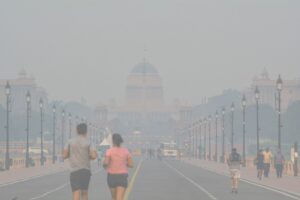 Delhi NCR is once again grappling with a severe air pollution episode, prompting the Commission for Air Quality Management (CAQM) to enforce Stage-I measures of the Graded Response Action Plan (GRAP) on May 16. The decision follows a rapid rise in the city’s pollution levels, driven by strong winds that carried dust from distant regions, pushing the Air Quality Index (AQI) to a concerning 278. Forecasts by the India Meteorological Department (IMD) and the Indian Institute of Tropical Meteorology (IITM) indicate that these poor air quality conditions are likely to persist at least through May 17.
Delhi NCR is once again grappling with a severe air pollution episode, prompting the Commission for Air Quality Management (CAQM) to enforce Stage-I measures of the Graded Response Action Plan (GRAP) on May 16. The decision follows a rapid rise in the city’s pollution levels, driven by strong winds that carried dust from distant regions, pushing the Air Quality Index (AQI) to a concerning 278. Forecasts by the India Meteorological Department (IMD) and the Indian Institute of Tropical Meteorology (IITM) indicate that these poor air quality conditions are likely to persist at least through May 17.
Despite recent official claims of progress, with only two ‘poor’ air days recorded in the first half of May 2025 the lowest in four years the sudden spike has reignited political fault lines. The Aam Aadmi Party (AAP) lashed out at the Bharatiya Janata Party (BJP), accusing it of failing to deliver on promises of clean air. AAP cited pollution levels exceeding 500 in some localities and criticized what it described as years of inaction by the BJP on air quality control.
The confrontation escalated further after Delhi Minister Manjinder Singh Sirsa pushed back against former Chief Minister Atishi’s allegations, asserting that the recent pollution was an aberration caused by a dust storm and not reflective of the overall trend. While both parties traded blame over the city’s environmental management, the Central Pollution Control Board (CPCB) maintained that the AQI stood at a ‘poor’ level of 278 on May 16.
The GRAP Stage-I enforcement calls for targeted measures such as enhanced street cleaning, regulation of construction dust, and tighter emission controls on vehicles and industrial activity. The CAQM stressed the urgency of implementing these steps to prevent the situation from deteriorating further.
As the capital battles recurring pollution crises each year, the latest developments highlight the complex interplay between environmental science, governance, and political accountability in one of the world’s most polluted urban centers.
